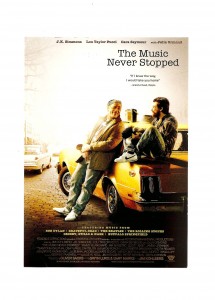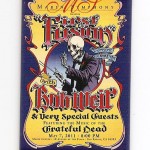-
LEAPING INTO 2012
LEAPING…BLOG TO BE POSTED:
Let’s skip Saturday night……..
-
THE MUSIC NEVER STOPPED
WATCH THE MOVIE!!!
-
DANCING IN THE STREET
The beat in the street began in L.A. in the early sixties at the beatnik beach scene in Marina Del Rey and east up Slauson Street, where the musicians gathered outside to play jazzy soulful rock and the neighbors created a new dance, and spreading across America, people began dancing in the street. They were doing it to the Motown sound in Detroit, shuffling in Baltimore and D.C., rockin’ in the city of Chicago and the village of New York, and street danced every time I been to New Orleans; and in Philly, for a week at the Tower Theatre I remember the Grateful Dead doing “Dancing in The Street” and lit up the floor with contagious energy each night. They’ve been playin’ this song since 1966. This sound first came on the radio in 1964 recorded by Martha and the Vandellas. The year before, Round Robin, Darlene Love, The Turtles & others were bringing new sounds & creating new steps in the streets of south L.A. When I first moved to California in 1971 I lived in Redondo Beach, about a dozen miles south of this scene. And in the decade before when it was happening, I was a teenager with his ear glued to my radio each day. After school I’d head upstairs to the attic over the garage and listen to the latest old and new songs & everyday I would make up my own top ten favorite songs of the day. When I heard “Kick That Little Foot Sally Ann” it immediately made my top ten. I saw Round Robin, who recorded this song, on the Lloyd Thaxton show on TV, with singers & sax, doing a dance they called The Slauson. I went out and bought the 45 record. The flip side has an instrumental “Slauson Party”. I remember this dance because of the little kick of the choreographed line, while Round Robin sang and snapped his fingers. In my later teenage years I was introduced to a song and dance I really liked, “Electric Slide” at a wedding, and it had some similar steps. Today you find much of the hip hop sound in these same neighborhood streets, and when crossing Crenshaw and Slauson streets in L.A., folks in modern day, you tubers and all, call the slauson the salsa now.
Kick that little foot Sally, Sally
Kick that little foot Sally Ann.
Kick that little foot Sally, Sally,
Do the slauson Sally Ann.Well I saw Sally at the party
(Kick that little foot, Sally Ann)
A-looking lonely as can be
(Kick that little foot, Sally Ann)
She said, I don’t know how to slauson
(Kick that little foot, Sally Ann)
I said, get up from that chair and follow me.Kick that little foot Sally, Sally
Kick that little foot Sally Ann.
Kick that little foot Sally, Sally,
Do that slauson Sally Ann.Well Sally got up on the dance floor.
(Kick that little foot Sally Ann)
By the second dance she was a-doing fine.
(Kick that little foot Sally Ann)
And now they call her queen of the slauson
(Kick that little foot Sally Ann)
You can’t get her out of that slauson line.Kick that little foot Sally, Sally
Kick that little foot Sally Ann.
Kick that little foot Sally, Sally,
Do that slauson Sally Ann.
(Instrumental break)
Kick that little foot Sally, Sally,
Kick that little foot Sally Ann.
Kick that little foot Sally, Sally,
Do that slauson Sally Ann. -
WHEN THE MUSIC HITS THE AIR
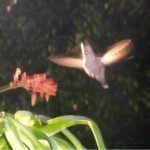 The day begins with a hummingbird’s song in the air, then a long morning walk, part of the annual Human Race in San Rafael, to help raise awareness and support for local non-profits, education, caregivers and groups that provide community services and help for people with developmental disabilities. Our walk (or run or roll) is around the Civic Center lagoon and the Marin Center fairgrounds and there are musical groups singing in the open air, and volunteer cheerleaders along the way to encourage those not used to this early morning walk, and we circle the Marin center where Bob Weir is playing with the Symphony tonight, a unique experiment called “First Fusion”. I was apprehensive about going because of a stigma about symphony orchestras. When I was a kid, my dad would make me watch TV whenever a concert symphony or opera was on so I could “get culture”. I never did care for Lawrence Welk or a Leonard Bernstein composition and I generally avoid symphonies for this reason. Bob Weir changed my mindset about what to listen for in music. This was called longhair music before the Beatles and is enjoyed mainly by squares. My kids were raised without television and followed their own musical instincts, and danced ballets, Michael Jackson or with a skateboard. This night would be a night of redemption and healing for me.
The day begins with a hummingbird’s song in the air, then a long morning walk, part of the annual Human Race in San Rafael, to help raise awareness and support for local non-profits, education, caregivers and groups that provide community services and help for people with developmental disabilities. Our walk (or run or roll) is around the Civic Center lagoon and the Marin Center fairgrounds and there are musical groups singing in the open air, and volunteer cheerleaders along the way to encourage those not used to this early morning walk, and we circle the Marin center where Bob Weir is playing with the Symphony tonight, a unique experiment called “First Fusion”. I was apprehensive about going because of a stigma about symphony orchestras. When I was a kid, my dad would make me watch TV whenever a concert symphony or opera was on so I could “get culture”. I never did care for Lawrence Welk or a Leonard Bernstein composition and I generally avoid symphonies for this reason. Bob Weir changed my mindset about what to listen for in music. This was called longhair music before the Beatles and is enjoyed mainly by squares. My kids were raised without television and followed their own musical instincts, and danced ballets, Michael Jackson or with a skateboard. This night would be a night of redemption and healing for me.
This is the same stage, I’ve seen many times “The Nutcracker” was performed on, and recollect like yesterday Jerry Garcia’s Band playing and Robert Hunter nearby. Of course we’re all seated for the performance, as are the musicians, except for the conductor and Bob Weir. Tonight there is a jury of singers, two rows of six vocalists dressed in black and white and it’s a swingin’ singin’ symphony, better than a Walt Disney silly one, and stirs up rich moments remembering Kubrick’s musical journey through 2001: A Space Odyssey. The theme of this first set, like a concertino, with many supportive instruments, violins, strong bass and keys building towards the concerto, as we listen to the melody with great harmony, and unity, as the tones set the color and the musical texture. Bobby gets the rhythm in motion and we listen to the combined effect, the inextricable web of timbre sound as it’s deeply rooted. “A perfect Cassidy/Bird Song sandwich!” someone says at break. The highlight of the first set for me is “Row Jimmy”. This song was built for this bigger band and it’s about square dancing the dopaso. The orchestra gives this song color and texture while the Grateful Dead version is more of an outline. When the music hits the air magic happens. This opening segment is called “Raising the Dead” and it opens a flood of memories, of seeing Jerry Garcia for the first time at a play called “Tarot” in New York City, written by early Grateful Dead keyboardist Tom Constanten, and Jerry appears in this musical play as a guest guitarist.
I was a student teacher and attended the show with a half dozen other student teachers who shared a house in the Bronx. The play was a dramatic composition of musical vignettes, a terrapin, lovers walking in a magical forest, maidens waltzing, the birthing scene, the mystic carpenter and the space voyage, and then climax came when a trap door opens for the raising of the dead with orchestral sounds, horns and flutes, and amazing light show. The group of us returned home that night totally inspired to do a similar thing. Interesting conversation developed and I started writing down the dialogue around the table and assigning characters to describe each person’s part and the result a few months later was our own successful off-Broadway play, “Search Of The Candlemaker”. That night after seeing Garcia I started listening to “Workingman’s Dead”, then over and over and then “American Beauty”, an endless inspiration during that season.The sounds here are big and Robert Hunter supplies us with the poetry for the evening. He is the musical poet laureate behind Jerry Garcia and the Grateful Dead and these songs translate and transform, change and heal.
The second set brings in the full symphony orchestra, more than fifty musicians, and the Quartet San Francisco, with composer-arranger, Dr. Giancarlo Aquilanti conducting, and their fun begins with Playin’ in the Band > Uncle John’s Band > Dark Star (verse 1) > Jack Straw. It’s a perfect progression and the harmony between the two characters in Jack Straw, sung by Bobby and Jeff Chimenti, complement the sound with transposition, and then pause, for the gem “Days Between”. Members from the rock band Ratdog are playing with the symphony tonight. “Dark Star” starts up again (verse 2) > Uncle John’s Band (reprise) > Playin’ In The Band (reprise). One by one the orchestra members get up and leave. Bob walks off, and the Midnight Band vocalists present him with a beautiful bouquet of flowers.One by one some of the orchestra returns and then the encore! Only Bob Weir could take a rock ‘n roll song like “One More Saturday Night” and sing it with a symphony orchestra with new vibration and velocity that takes the conductor to new heights. It only makes sense the Grateful Dead would be interested in this kind of arrangement, to do a benefit for the Marin Symphony, and education, and draw from their roots and background and friends, and “Ripple” fits here perfectly. The closing song “Attics of My Life”, a capella, brings the very best moment of the night. Members of tonight’s group stand together in a beehive circle while Bob walks to the piano and hits a note several times, then slowly walks in front to the center of the group, and waits for silence in the audience to begin to sing. It is a moment to savor of ultimate absolute peace, peace of mind, silence without sound, peace of heart, unity in spirit, perfect harmony among the singers of the song, vocal chords as a coalition of instruments, planting poetry in the heart, peace in sound, humming along, a song, with voices in the air, with love and care, for all listeners with an ear to hear. This first fusion brought us to this oneness and opens the realm of musical possibilities.
-
SWARM A TREASURE FOR A PIPING QUEEN
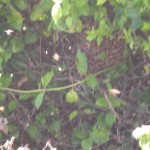
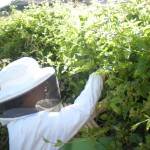
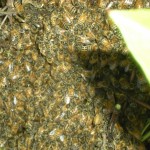
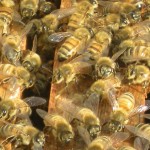
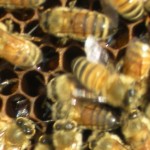
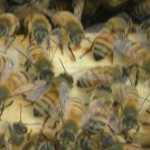
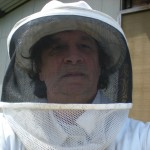 SWARM A TREASURE FOR A PIPING QUEEN
SWARM A TREASURE FOR A PIPING QUEENI visited with my daughter on Father’s Day and she receives a call in the afternoon from a neighbor who has a swarm of bees in their garden. She asks me if I want to go on a bee expedition and I agree and we take the bee suits. Ironically, this past Mother’s Day she is visiting with her Mom at her sister’s and there is a swarm of bees up in the tree. She doesn’t have her beesuit and her sister offers to construct one. She uses strong stocking netting to cover her face, a tyvek suit, and is well covered except for the thin gardener’s gloves on her hands. She climbs a ladder up the tree, takes the swarm, guides them into the box and brings them home to a beehive. She was stung many times on her hand up in the tree and added padded welder’s gloves to successfully move the bees from one neighborhood to another two hundred miles away. These are aggressive bees.
We suit up in our bee suits in the garden down the street where we see a swarm of bees that she says are probably Italian bees, which tend to be docile. There are over 10,000 bees in this swarm and they form a sphere or ball. She cuts through the branches and reaches in to encompass the ball of bees with her hands and guides the moving sphere into the box. Some of the bees are hovering above and around and there is space for the bees to enter or exit the box. She says we should go and return in about two hours when it cools down, and the rest of the bees will go in.
We go visit the hive that is on this property and there is a new queen that has just hatched. She is newborn and royal, the leader of the whole pack, as long as no other queens show up, for only one will survive to rule the hive. A newborn queen makes a piping sound. It’s her first sound and beekeepers rarely if ever hear it. We hear it this day and it’s one of the most beautiful sounds in all of nature. It’s a shrill sound and sounds like a baby crying, a soft persistent sound, louder than all the other bees, crying into the wind, birthing her rule, this Queen Piper is musical and closing my eyes all I hear is a baby’s cry. We return to the box and all the bees from the swarm have entered and settle in their hive that is their new home.


